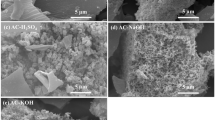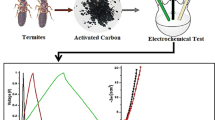Abstract
The cost-effective activated carbon based from waste cotton stalks by the KOH activation method is investigated as the electrode material in supercapacitor for the first time. Activation temperature control is one of the most important factors affecting the surface area and pore structure of activated carbon, and it influences the capacitive performance of activated carbon based from cotton stalk. The optimized conditions are as follows: cotton stalk base charcoals and activating agent with a mass ration of 1:4, at an activation temperature of 600, 700, and 800°C for 1, 1, and 2 h, respectively. With these experimental conditions, the activated carbon presents excellent electrochemical characteristics. The specific capacitance of the prepared activated carbon was as high as 180 F g−1at 2 A g−1 in 1.0 mol·L−1 Et4NBF4/AN electrolyte and the specific capacitance without obvious attenuation after 2000 cycles. So, it is reasonable to believe that the activated carbons from cotton stalks by the KOH gradient constant temperature activation method might be one of the innovative carbon electrode materials for supercapacitor.








Similar content being viewed by others
References
Qua QT, Shia Y, Tiana S, Chena YH, Wua YP, Holzeb R (2009) J Power Sources 194:1222–1226
Wu YP, Dai XB, Ma JQ, Cheng YJ (2004) Lithium ion batteries—practice & applications. Chemical Industry Press, Beijing
Xing W, Qiao SZ, Ding RG, Li F, Lu GQ, Yan ZF (2006) Carbon 44:216–224
Lota G, Centeno TA, Frackowiak E, Stoeckli F (2008) Electrochim Acta 53:2210–2216
Bentley P, Stone DA, Schofield N (2005) J Power Sources 147:288–294
Zhang JT, Gong LY, Kang S, Jiang JC, Zhang XG (2012) J Solid State Electrochem 16:2179–2186
Liang HC, Chen F, Li RG, Wang L, Deng ZH (2004) Electrochim Acta 49:3463–3467
Iijima S (1991) Nature 354:56–58
Gao B, Hao L, Fu QB, Su LH, Yuan CZ, Zhang XG (2010) Electrochim Acta 55:3681–3686
Pekala RW (1988) Stone RE. Polymer preprint 29:204–206
Pekala RW (1989) J Material Science 24:3221–3227
Du X, Guo P, Song HH, Chen XH (2010) Electrochim Acta 55:4812–4819
Zhang LL, Zhou R, Zhao XS (2010) J Mater Chem 20:5983–5992
Liu YF, Hu ZH, Xu K, Zheng XW, Qiang G (2008) Acta Phys. Chim Sin 24:1143–1148
Ahmadpour A, Do DD (1997) Carbon 35:1723–1732
Subramanian V, Luo C, Stephan AM, Nahm KS, Thomas S, Wei BJ (2007) J Phys Chem C 111:7527–7531
Wu FC, Tseng RL, Hu CC, Wang CC (2004) J Power Sources 138:351–359
Wu FC, Tseng RL, Hu CC, Wang CC (2005) J Power Sources 144:302–309
Balathanigaimani MS, Wang GS, Lee MJ, Chan K, Lee JW, Hee M (2008) Electrochem Commun 8:868–871
Wang XF, Tian Y (2010) Int Mater Rev 24:21–27
Guo YP, Qi JR, Jiang YQ, Yang SF, Wang ZC, Xu HD (2003) Mater Chem Phys 80:704–709
Li X, Xing W, Zhuo SJ, Qiao SZ, Lu GQ (2011) Bioresour Technol 102:1118–1123
Olivares-Marína M, Fernández JA, Lázaro MJ, Fernández-González C, Macías-García A, Gómez-Serrano V, Stoeckli F, Centenob TA (2009) Mater Chem Phys 114:323–327
Ma YW, Xiong CY, Huang W, Zhao J, Li XA, Fan QL, Huang W (2012) Chinese J Inorg Chem 28:546–550
Akdeniz RC, Acaroglu M, Arif H (2004) Energ Source 26:65–75
Deng H, Zhang GL, Xu XL, Tao GH, Dai JL (2010) J Hazardous Materials 182:217–224
Ahmadpour A, Do DD (1996) Carbon 34:471–479
Armandi MB, Bonelli F (2010) Geobaldo, Garrone E. Micropor Mesopor Mater 132:414–420
Deng H, Li G, Yang H, Tang J (2010) Chem Eng J 163:373–381
Ioannidou O, Zabaniotou A (2007) Renewable and Sustainable Energy Reviews11:1966–2005
Akdeniz RC, Acaroglu M, Arif H (2004) Energ Source 26:65–75
Prahas D, Kartika Y, Indraswatin N (2008) Chem Eng J 140:32–42
Stoeckli HF (1990) Carbon 28:1–6
Andrian EI, Steven W (2010) Bioresour Technol 101:3534–3540
Choy KKH, Barford JP, McKay G (2005) Chin J Chem Eng 109:147–165
Ganan J, González-Garcia CM, Gonzáleza JF, Sabioa E, Macias-Garciab A, Diaz-Diez MA (2004) Appl Surf Sci 238:347–354
Daud WMAW, Ali WSW (2004) Bioresour Technol 93:63–69
Marsh H, Rodriguez-Reinoso F (2006 ) Activated carbon (Elsevier), pp 322–365
Lillo-Ródenas MA, Juan-Juan J, Cazorla-Amoros D, Linares-Solano A (2004) Carbon 42:1371–1375
Li W, Zhang LB, Peng JH, Li N, Zhu XY (2008) Ind Crop Prod 27:341–347
Barsoukov E, Macdonald JR (2005) Impedance spectroscopy: theory, experiment, and applications. Hoboken, NJ, pp. 478–479
Zhou J, Xing W, Zhuo SP, Zhao Y (2011) Solid State Sci 13:2000–2006
Acknowledgments
The authors are grateful for support from Advanced Carbon Materials Research Laboratory, College of Materials Science and Engineering, Beijing University of Chemical Technology.
This work was supported by the Xinjiang science and technology aid project in Xinjiang (No.2013911049), Industrial Science and technology project of Shaanxi Province (NO.2016GY-170), the “West Light” Talents Cultivation Program of the Chinese Academy of Sciences (No.XBBS200919), and the Foundation of State Key Laboratory of Chemical Resource Engineering (BUCT).
Author information
Authors and Affiliations
Corresponding authors
Rights and permissions
About this article
Cite this article
Li, W., Wumaier, T., Chen, M. et al. Effect of the gradient constant temperature on the electrochemical capacitance of cotton stalk-based activated carbon. J Solid State Electrochem 20, 2315–2321 (2016). https://doi.org/10.1007/s10008-016-3235-2
Received:
Revised:
Accepted:
Published:
Issue Date:
DOI: https://doi.org/10.1007/s10008-016-3235-2




